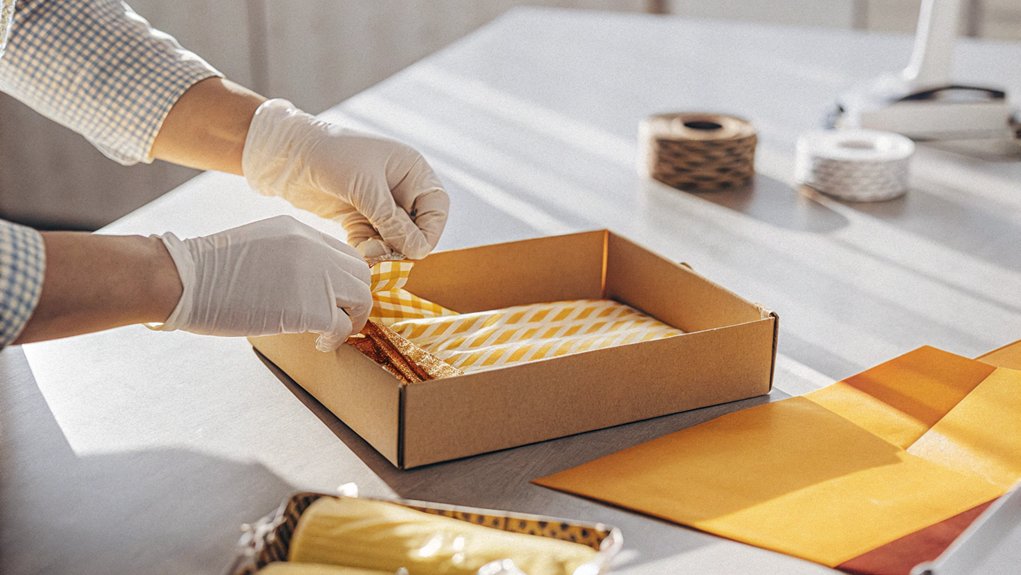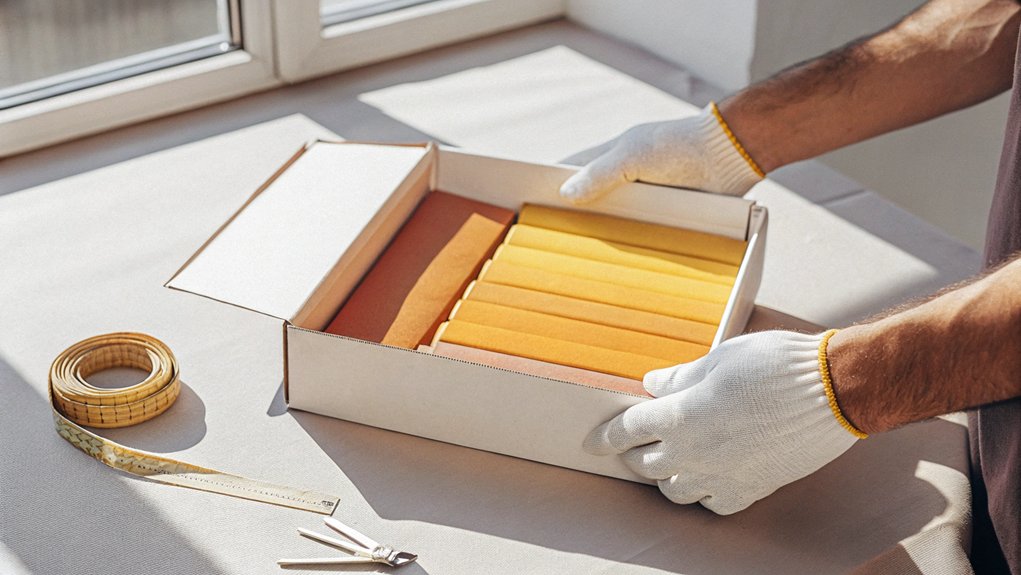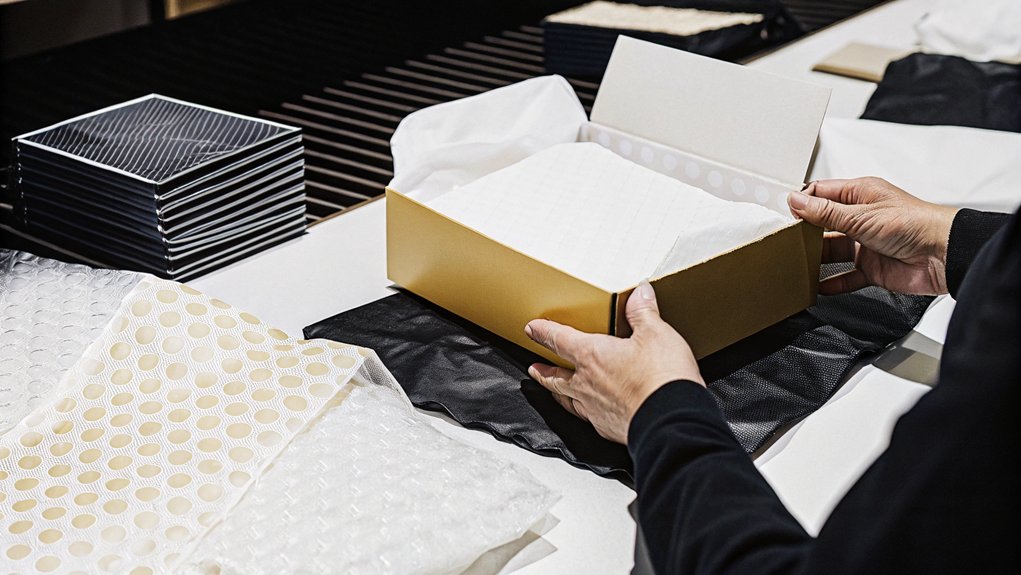Manual Packing: Ensuring Quality in Every Package
A perfectly sealed package is like a promise kept; it reflects the care put into every detail. In a world dominated by automation, the role of manual packing stands out as a critical checkpoint for quality assurance. By examining each component closely, you can prevent potential errors that could tarnish a brand’s reputation. What are the key steps that guarantee this meticulous process? Understanding them could redefine your approach to packaging.
 Achieving quality in manual packing requires a structured approach that outlines the key steps in the process.
First, inspect all packing materials to confirm they meet quality standards. Next, focus on the training of personnel; well-trained staff can reduce packing errors considerably.
Implement checklists to verify secure sealing and proper labeling of each package, as packaging faults can lead to costly recalls.
Adopt a systematic approach, including regular audits, to maintain consistency and uphold the quality control process.
Encourage continuous improvement by establishing feedback loops to adapt to changing consumer demands.
With attention to detail at every step, your team can create a reliable packing process that fosters both belonging and excellence within the organization.
Achieving quality in manual packing requires a structured approach that outlines the key steps in the process.
First, inspect all packing materials to confirm they meet quality standards. Next, focus on the training of personnel; well-trained staff can reduce packing errors considerably.
Implement checklists to verify secure sealing and proper labeling of each package, as packaging faults can lead to costly recalls.
Adopt a systematic approach, including regular audits, to maintain consistency and uphold the quality control process.
Encourage continuous improvement by establishing feedback loops to adapt to changing consumer demands.
With attention to detail at every step, your team can create a reliable packing process that fosters both belonging and excellence within the organization.
 When you consider the benefits of manual packing for quality control, it’s clear that this approach offers distinct advantages over automated systems.
Manual packing allows trained personnel to apply their expertise, ensuring that packaging materials meet quality standards and reducing the risk of packaging failures. With a keen attention to detail, these workers can identify defects or inconsistencies that automated systems might miss, promoting consistent quality.
Additionally, manual packing’s flexibility accommodates unique product shapes, enhancing product protection and presentation. Immediate problem-solving during the packing process allows for quick adjustments, fostering a culture of reliability.
This meticulous approach ultimately builds consumer trust and brand loyalty, making manual packing an invaluable asset for maintaining high-quality standards in every package.
When you consider the benefits of manual packing for quality control, it’s clear that this approach offers distinct advantages over automated systems.
Manual packing allows trained personnel to apply their expertise, ensuring that packaging materials meet quality standards and reducing the risk of packaging failures. With a keen attention to detail, these workers can identify defects or inconsistencies that automated systems might miss, promoting consistent quality.
Additionally, manual packing’s flexibility accommodates unique product shapes, enhancing product protection and presentation. Immediate problem-solving during the packing process allows for quick adjustments, fostering a culture of reliability.
This meticulous approach ultimately builds consumer trust and brand loyalty, making manual packing an invaluable asset for maintaining high-quality standards in every package.
 Skilled labor is essential in manual packing processes because their expertise directly impacts the quality of packaging. By employing trained workers, you greatly reduce packaging errors that could damage products or disappoint customers.
The benefits of skilled labor include:
Skilled labor is essential in manual packing processes because their expertise directly impacts the quality of packaging. By employing trained workers, you greatly reduce packaging errors that could damage products or disappoint customers.
The benefits of skilled labor include:
 Quality packaging is essential for enhancing customer satisfaction, as it directly influences consumers’ perceptions and purchasing decisions. When you prioritize quality in your packaging, you not only meet consumer expectations but also reinforce your brand integrity.
Manual packing processes, backed by rigorous quality control, help guarantee product integrity during transit, reducing the likelihood of returns and fostering trust. In fact, companies like OpsNinja report a 40% reduction in customer complaints when quality packaging is prioritized.
With 65% of consumers more likely to repurchase from brands that use high-quality packaging, your focus on quality can greatly enhance the overall customer experience, leading to increased brand loyalty and repeat business.
Invest in quality packaging; your customers will thank you.
Quality packaging is essential for enhancing customer satisfaction, as it directly influences consumers’ perceptions and purchasing decisions. When you prioritize quality in your packaging, you not only meet consumer expectations but also reinforce your brand integrity.
Manual packing processes, backed by rigorous quality control, help guarantee product integrity during transit, reducing the likelihood of returns and fostering trust. In fact, companies like OpsNinja report a 40% reduction in customer complaints when quality packaging is prioritized.
With 65% of consumers more likely to repurchase from brands that use high-quality packaging, your focus on quality can greatly enhance the overall customer experience, leading to increased brand loyalty and repeat business.
Invest in quality packaging; your customers will thank you.
Key Takeaways
- Inspect packing materials for compliance with quality standards to ensure product safety and integrity.
- Train personnel thoroughly to minimize errors and enhance packing efficiency.
- Utilize checklists for secure sealing and accurate labeling to maintain consistency.
- Conduct regular audits to uphold quality control and identify areas for improvement.
- Invest in skilled labor to foster attention to detail and quick problem-solving during the packing process.
The Importance of Quality in Manual Packing
While you may appreciate the personalized touch of manual packing, it’s vital to recognize that quality in this process directly impacts your brand reputation and consumer trust. Manual packing, while offering that unique feel, is inherently more time-consuming and susceptible to human errors. These errors can lead to inconsistencies that compromise packaging standards, affecting durability and presentation. A significant percentage of product recalls highlights the importance of stringent quality control in this domain. To foster brand loyalty, implementing systematic checks and providing thorough training for your staff are necessary. Regular workshops can reinforce high-quality standards, reducing errors and enhancing overall output. By prioritizing quality in manual packing, you build stronger consumer trust and maintain a lasting connection with your audience.Key Steps in the Manual Packing Process

Benefits of Manual Packing for Quality Control

The Role of Skilled Labor in Ensuring Quality

- Quality Control: They identify potential issues, ensuring adequate sealing and proper material choice before mass production.
- Consistency: A well-trained workforce maintains uniform product presentation, enhancing your brand image and fostering consumer trust.
- Efficiency: Continuous training leads to improved packing speed, reducing labor costs while sustaining high-quality standards.
Enhancing Customer Satisfaction Through Quality Packaging
